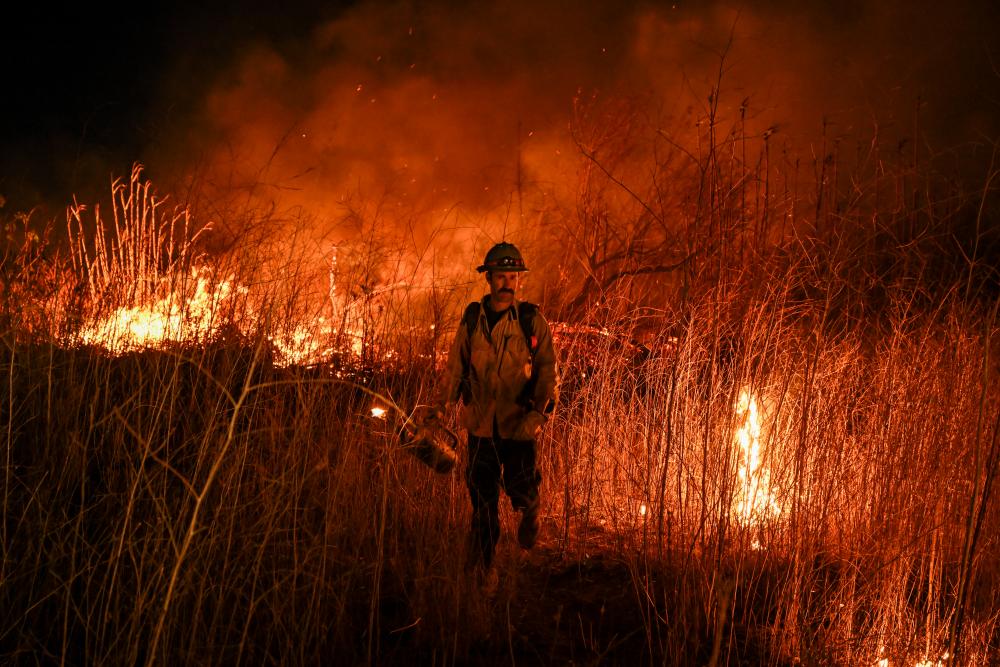As federal firefighters grapple with strained resources in an intense year of fire activity, Democratic lawmakers are demanding answers from the Trump administration about how severe cuts to staffing and budgets at the US Forest Service may have hamstrung wildfire preparation and response.
Leaders at the agency and the US Department of Agriculture, which oversees it, have repeatedly assured the public and Congress that they were fully prepared for the critical fire season that’s already well under way.
But internal data, first reported by the Guardian last month, painted a dangerously different picture, with more than a quarter of firefighting roles left unfilled in mid-July, just as fire activity and risks spiked. Trump administration policies designed to rapidly shrink the federal government have also left significant gaps in the workforce that supports wildfire mitigation and suppression.
In a letter issued Thursday, the representative Robert Garcia, the top Democrat on the House oversight committee, gave USDA secretary Brooke Rollins two weeks to provide documents with a detailed accounting of firefighter staffing and support personnel, and called for clarity from the USFS on information that’s largely been shielded from the public.
“The Forest Service’s firefighting capacity has been dangerously hampered by Department of Government Efficiency and Trump Administration layoffs, deferred resignations, and other early retirements and resignations just as climate change is extending the fire season,” Garcia wrote in the letter, requesting specifics that would show “the extent to which the Trump Administration’s policies have affected the ability of firefighters to protect the American public”.
Staffing reports produced on 17 July showed that more than 5,100 positions at USFS were unfilled, more than 26% of positions. The issue was especially grim in the Pacific north-west, a region facing extremely high fire risk this year, with a vacancy rate of 39%. The intermountain region, the largest region with close to 34m acres (14m hectares) of forestlands that stretch across parts of Utah, Nevada, Wyoming, Idaho and California, has nearly 37% of jobs unfilled.
Weeks before the reports, Tom Schultz, the chief of the USFS, told senators the agency was reaching its firefighting capacity and had hit 99% of hiring goals.
The staffing numbers fail to capture the strain being felt in specific areas within these regions where ranks are severely thin. There are reports of USFS crews staffed with less than half of the positions once considered necessary to be fully operational.
Six federal firefighters, who asked for anonymity because they are barred from speaking publicly, described in July how the staffing shortages had complicated crews’ ability to suppress large fires and contribute to increased injuries and risks for firefighters on the ground.
“There is definitely a lot of tension in the system this season,” said a fire captain, describing how these issues have long plagued the agency. “It’s sort of like that medieval torture device that stretched people – just one more crank.”
That captain speculated that the agency might be exploiting the difference between “minimum” staffing requirements and what was traditionally considered “fully staffed”. “You can technically play a football game with 11 people on the team,” he said. “It would be considered negligent, maybe even abusive to the players, but they signed up to play and it’s technically allowed.”
Along with reports of dangerous holes left on firefighting teams, there have been deep cuts to support staff that have negatively affected crews on the fire line. USFS hasn’t disclosed specific numbers and it remains unclear exactly how many employees have been pushed out of the agency this year, either through firings or programs incentivizing resignation and early retirement, but estimates shared by the US senator Patty Murray go up to 7,500 people. Among them were 1,400 people with so-called “red cards”, non-professional firefighters who trained to join operations on the fire line if needed.
The Department of Agriculture, which oversees the forest service, has tried to address the loss of employees with fire qualifications by calling for those with red cards who took early resignation or retiring offers to voluntarily return for the season and take on fire assignments until their contracts end. By 21 July, 65 had returned and been mobilized, according to a USDA spokesperson.
This year, there have already been reports of crews being left without power for weeks due to cut maintenance workers, paychecks being late or halved because administrative roles were left empty, or firefighters having to mow lawns outside their offices, manage campsites and do plumbing work at their barracks in addition to their other duties. In Oregon, firefighters reportedly went hungry after their 16-hour shifts and ran low on medical supplies as a result of the staffing challenges.
“Lost staff include administrative and human resources personnel, food service and sanitation workers, scientists, foresters, meteorologists, and others with deep institutional knowledge that help firefighters do their jobs,” Garcia wrote in the letter. “These staffing cuts and vacancies have firefighters covering tasks, such as answering phones and cleaning toilets, rather than fighting fires.”
While Schulz has publicly said USFS is adequately staffed, he acknowledged the challenges in an internal memo sent to agency leadership in July, shared with the Guardian.
“As expected, the 2025 fire year is proving to be extremely challenging,” he wrote. Forecasts issued from the Climate Prediction Center and Predictive Services indicate the season is far from slowing. Higher-than-normal temperatures are predicted for much of the US through September, along with drier-than-normal conditions, creating high risks for big burns.
“We have reached a critical point in our national response efforts and we must make every resource available,” Schultz added. “At times like this we know the demand for resources outpaces their availability.”
With his request, Garcia is hoping to find out exactly how the agency is calculating its numbers and where gaps may still exist.
Lawmakers are asking Rollins to provide “a detailed and comprehensive accounting of current staffing and staffing changes at the Forest Service including firefighting jobs and individuals with red cards, as well as administrative personnel, support staff, and other positions which contribute to disaster preparedness and firefighting, organized by region, since January 20, 2025”. They’re also requesting documents and communications pertaining to the administration’s firings and the programs that pushed thousands of staffers to resign or retire.
In May, Rollins directed the USFS chief to provide an analysis on how the voluntary departures affected firefighting and fire support, along with a plan to “remedy critical vacancies”, but those numbers and strategies were never made public. Garcia has officially requested documentation and communications on this memo as well.
Garcia represents parts of Los Angeles, the city hit by a disastrous and deadly firestorm in January that left neighborhoods leveled and killed 31 people.
“Our federal wildland firefighters are on the frontlines of our battle against natural disasters, yet the Trump Administration continues to slash essential personnel, even as we face longer and ever more dangerous wildfire seasons,” Garcia said in a statement to the Guardian. “The Department of Agriculture owes the American people answers on why the agency is understaffed and how they plan to safeguard communities nationwide, especially as millions of acres continue to burn across the country.”

